If you're looking to reverse receding gum disease, consider using red and near-infrared light wavelengths between 660 nm and 830 nm. These wavelengths increase cellular energy, promote tissue regeneration, and improve blood circulation, making your gums healthier. Regular use can speed up the healing process and reduce inflammation, giving you relief from discomfort. Additionally, combining this therapy with good oral hygiene practices enhances results. If you explore further, you'll discover more on how to effectively integrate this therapy into your daily routine for the best outcomes.
Effective Wavelengths for Gum Healing
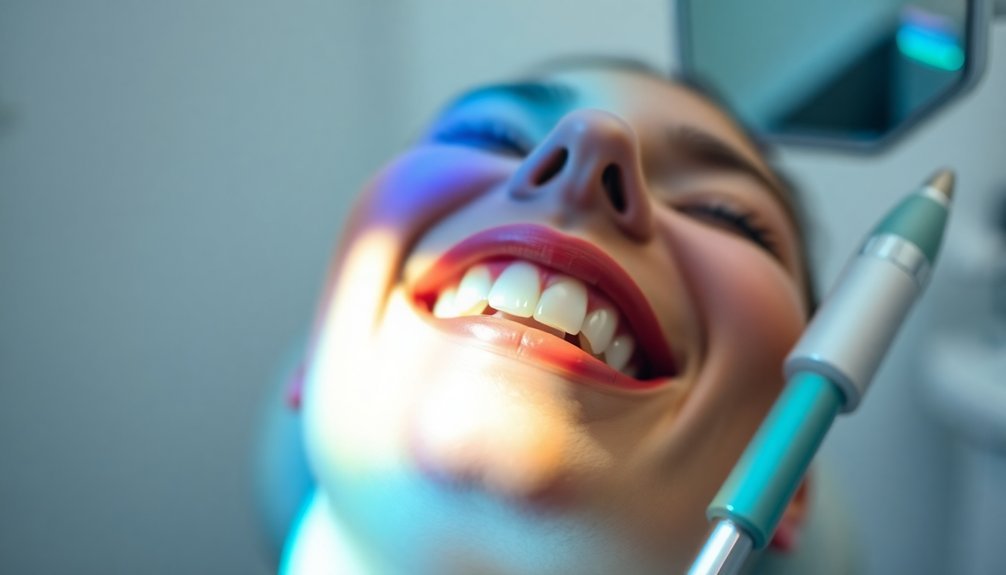
Effective wavelengths play an essential role in the healing process of gum disease. When you undergo periodontal therapy, specific laser wavelengths like Er:YAG and Nd:YAG are particularly effective.
The Er:YAG laser is great for gently removing calculus and infected tissue without causing trauma. You can benefit from its ability to do this without local anesthesia, which minimizes discomfort and avoids microfractures. Additionally, the therapy utilizes dual wavelengths to maximize bacterial reduction while promoting tissue regeneration.
On the other hand, the Nd:YAG laser excels in deep disinfection, targeting the diseased epithelial lining of the periodontal pocket. By creating a clean surface, it sets the stage for effective treatment and stimulates the growth of new tissues, including bone and the periodontal ligaments. This is vital for your overall gum health.
Combining these laser treatments enhances outcomes, offering a minimally invasive approach that maximizes safety and reduces healing times. Since these procedures often don't require anesthesia, you can enjoy a more comfortable experience.
Mechanism of Red Light Therapy
Red light therapy serves as a powerful adjunct to traditional laser treatments for gum disease, enhancing healing processes in a unique way. By penetrating deep into the gum tissue, red and near-infrared light allows photons to be absorbed by cells, markedly increasing cellular energy production. This boost in energy stimulates cellular repair mechanisms and promotes tissue regeneration, which aids in your healing process. One of the therapy's key advantages is its ability to reduce inflammation and alleviate pain. The anti-inflammatory properties not only mitigate swelling but also help prevent further gum damage. By improving blood circulation in the gums, red light therapy guarantees that essential nutrients and oxygen reach the affected areas, enhancing healing and overall gum health. Additionally, this treatment is effective when combined with good oral hygiene practices.
| Mechanism | Description | Benefit |
|---|---|---|
| Cell Stimulation | Increases cellular energy and repair mechanisms | Promotes tissue regeneration |
| Inflammation Reduction | Reduces swelling and chronic pain | Provides relief from discomfort |
| Blood Circulation | Enhances blood flow and nutrient delivery | Supports gum health improvements |
Benefits of Light Therapy
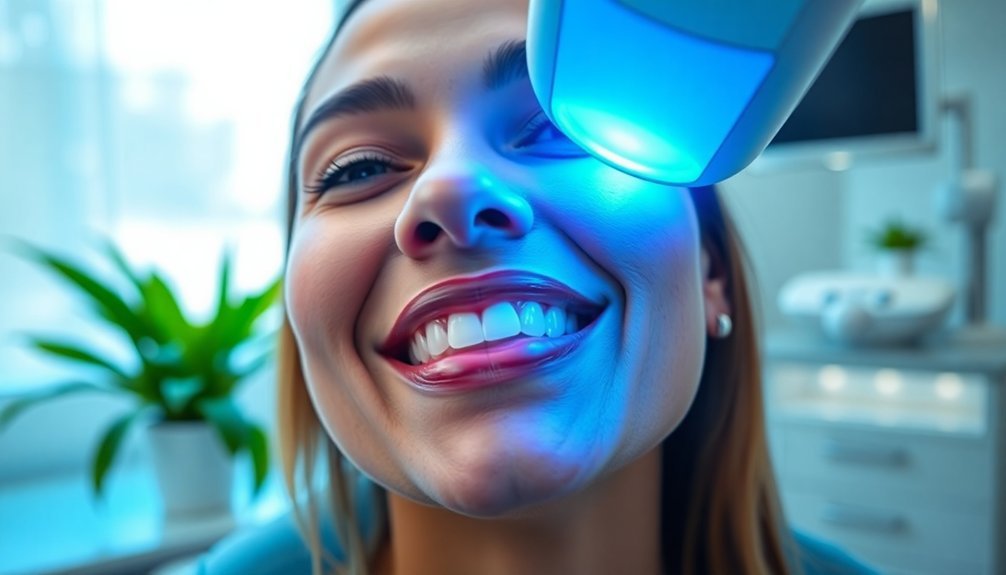
When you opt for light therapy, you're tapping into accelerated tissue healing and enhanced bacterial control that can greatly improve your oral health. This therapy not only speeds up the regeneration of gum tissue but also actively targets harmful bacteria, making it an effective complement to your dental care routine. You'll find that these benefits can lead to a healthier mouth and a more comfortable recovery from gum disease. Moreover, this treatment's germicidal properties can effectively combat harmful bacteria associated with gum issues.
Accelerated Tissue Healing
For those seeking solutions to gum disease, light therapy offers significant advantages in accelerated tissue healing. This innovative approach harnesses red light to enhance cellular energy production, leading to faster healing processes. By increasing ATP levels, red light energizes the cells in your gums, promoting repair and regeneration.
Here are some key benefits of light therapy for accelerated tissue healing:
- Boosts Cellular Energy: Red light energizes your cells, speeding up the healing process for damaged gum tissues.
- Enhances Circulation: Improved blood flow delivers vital oxygen and nutrients, reducing inflammation and promoting recovery.
- Reduces Inflammation: The therapy's anti-inflammatory properties help mitigate pain and swelling, creating a healthier environment for healing.
- Speeds Up Post-Surgical Recovery: If you've had dental procedures, light therapy accelerates healing, reducing downtime and discomfort.
Enhanced Bacterial Control
Light therapy plays an essential role in enhancing bacterial control for those struggling with gum disease. By utilizing photodynamic therapy with photosensitizers like methylene blue, you can greatly reduce harmful bacteria in your mouth.
When combined with specific wavelengths of light, this therapy not only targets microorganisms but effectively disrupts intact biofilms that harbor them.
Blue light, in particular, is known for its ability to kill periodontal disease-causing bacteria, such as *Porphyromonas gingivalis* and *Aggregatibacter actinomycetemcomitans*. This targeted therapy minimizes the overall bacterial flora, protecting beneficial bacteria while eliminating the harmful ones.
The unique photochemical reactions occurring during treatment lead to the destruction of bacterial cells, producing toxic substances that compromise their integrity.
Moreover, dual-light therapies that combine red and blue light enhance the treatment's effectiveness without triggering bacterial resistance. These methods can especially benefit individuals with aggressive strains or chronic conditions, offering a minimally invasive way to maintain their oral health.
With reduced bacterial populations and disease markers, you can enjoy a healthier mouth and improved quality of life.
LANAP Laser Therapy Overview
LANAP Laser Therapy represents a significant advancement in the treatment of gum disease, emphasizing precision and patient comfort. Utilizing the PerioLase MVP-7 laser, this procedure targets diseased gum tissue while leaving healthy tissue intact. The laser works by destroying bacteria in the periodontal pocket, helping to prevent recurrent infections.
Here's why LANAP could be a great choice for you:
- Minimally Invasive: No cutting or stitching needed, reducing your anxiety.
- Quick Recovery: Most patients can bounce back to their daily routine immediately, allowing you to live life without interruption.
- Reduced Discomfort: The procedure's design seals nerve endings, minimizing temporary discomfort.
- Natural Healing Response: It promotes the regrowth of gums and bone, giving you healthier teeth and a better smile.
Performed under local anesthesia, LANAP allows you to feel at ease throughout the treatment.
With its ability to reduce bleeding and gum pocket depths, this therapy stands out as an effective method for reversing receding gum disease, making it a preferred option for many people battling gum issues.
Clinical Studies on Effectiveness
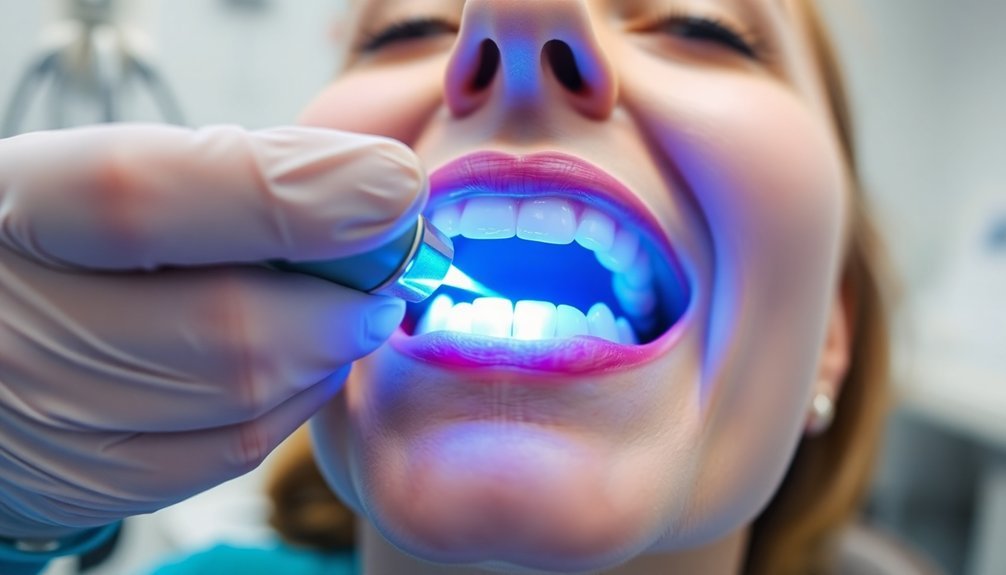
Clinical studies have shown that LANAP therapy is highly effective in treating gum disease, boasting an impressive success rate of 87.9%. This FDA-approved procedure, cleared since 2004, adheres to stringent safety standards and utilizes the specialized PerioLase MVP-7 laser for ideal periodontal health.
LANAP stands out as the only laser treatment protocol recognized for True Regeneration®.
Research indicates significant clinical outcomes, including new bone formation and reduced risk of tooth loss following the procedure. You'll likely experience prolonged improvements in your gum health, with minimal side effects reported over several years.
The laser's ability to selectively target unhealthy tissue while preserving healthy areas promotes effective healing.
The PerioLase laser not only vaporizes diseased gum tissue, but it also stimulates growth factors essential for natural recovery. Additionally, LANAP offers a quicker recovery compared to traditional surgery, meaning you could enjoy less pain and bleeding during your recovery.
The reduced risk of complications guarantees a smoother healing process, allowing you to focus on maintaining your oral health without the worry of severe post-operative issues.
Practical Home Applications
Harnessing the power of specific wavelengths can considerably enhance your oral health regimen at home. By incorporating red and blue light therapies, you can tackle receding gums and boost your overall dental health. Here are some practical applications to contemplate:
- Use a red light device: Aim for wavelengths between 660 nm and 830 nm for just 10 minutes daily. This encourages gum tissue regeneration and improves blood circulation.
- Incorporate blue light therapy: At 415 nm, blue light eliminates harmful bacteria and can even help whiten your teeth when partnered with a professional whitening gel.
- Combine light therapy with natural remedies: Try oil pulling with sesame or coconut oil to remove plaque, or use a saltwater rinse to soothe painful gums.
- Adopt everyday habits: Drinking green tea and using thyme essential oil can provide antibacterial benefits, while gentle brushing with a soft-bristled toothbrush prevents further damage to your gums.
Implementing these strategies not only enhances your oral care routine but also empowers you to take an active role in reversing gum disease.
Your smile deserves this attention!
Precautions for Light Treatment
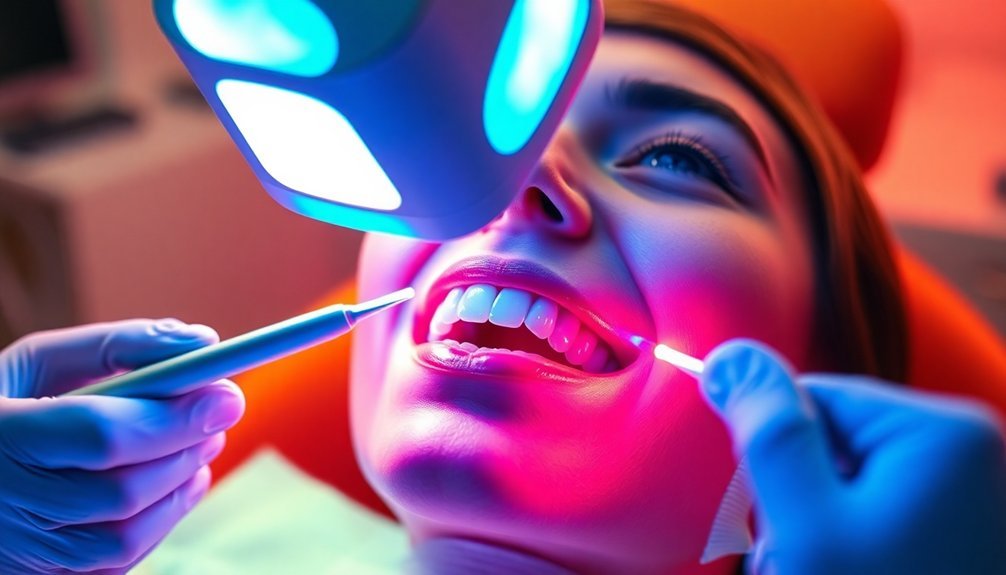
When you set out to incorporate light therapy into your gum care routine, it's essential to take certain precautions to guarantee safety and effectiveness. Here are some important considerations to keep in mind:
| Precaution | Details | Importance |
|---|---|---|
| Eye Protection | Always wear appropriate protective goggles. | Prevents potential eye damage. |
| Treatment Duration | Follow device guidelines; sessions last 10-20 min. | Guarantees proper exposure and effectiveness. |
| Consistency | Treat regularly; assess gum health progress. | Consistent therapy yields ideal results. |
| General Safety | Consult a professional; monitor gum response. | Confirm safety and adjust if discomfort occurs. |
Combining Light Therapy With Hygiene
You can enhance your gum health by combining daily light therapy with your regular oral hygiene routine.
Incorporating this simple step not only boosts healing but also reinforces the importance of consistent brushing and flossing.
Together, you'll tackle gum disease more effectively and promote overall oral wellness.
Daily Light Therapy Routine
Incorporating daily light therapy into your oral hygiene routine can greatly enhance gum health and aid in the recovery from dental procedures.
Regular use of red and blue light can make a noticeable difference, especially when combined with proper brushing and flossing.
Here's how to effectively integrate light therapy into your daily practices:
- Daily Ritual: Use red light therapy for 10 minutes each evening before brushing, promoting healing and reducing inflammation.
- Whitening Boost: Incorporate blue light therapy 2-3 times a week for 20 minutes to cleanse bacteria and enhance whitening effects.
- Regular Check-ins: Monitor changes in your gum health, tracking inflammation and bleeding to modify your routine as necessary.
- Device Selection: Choose devices like Lumebox, designed specifically for oral tissues, to guarantee you're getting the best results.
Importance of Oral Hygiene
A thorough oral hygiene regimen is vital for maintaining gum health, especially when combined with light therapy. Brushing twice a day for at least two minutes helps remove bacteria that can turn into plaque. Use a soft-bristled toothbrush to prevent further irritation to your gums, and if you can, brush after each meal for even better plaque removal.
Don't forget to floss daily; it clears plaque from those hard-to-reach areas between your teeth. Flossing before you brush can help remove loosened food particles, making your brushing more effective.
Regular dental cleanings are also essential. They allow your dentist to check for early signs of periodontal disease and remove tartar, which can lead to serious gum issues. These appointments provide personalized advice tailored to your specific oral health needs.
Lastly, watch your diet. A balanced intake rich in vitamins, especially vitamin C, supports gum health and aids in fighting off infections. Avoid sugary and acidic foods to reduce the risk of enamel weakening.
Frequently Asked Questions
Can Red Light Therapy Replace Traditional Gum Disease Treatments Completely?
Red light therapy can't fully replace traditional gum treatments—it's best as a complementary approach. Consult your dentist to combine therapies effectively, ensuring the best outcomes for your gum health while maintaining good oral hygiene practices.
How Often Should I Use Red Light Therapy for Best Results?
For best results, you should use red light therapy about 3-5 times a week, with each session lasting 10-15 minutes. Regular use is essential, so stay consistent to see improvements in your gum health.
Are There Any Side Effects of Red Light Therapy on Gums?
You won't experience any reported side effects from red light therapy on your gums. It's non-invasive and painless, making it a comfortable option. Just remember to consult your dental professional before starting treatment.
Is Blue Light Therapy Safe for All Patients With Gum Disease?
Yes, blue light therapy's generally safe for most patients with gum disease. It doesn't require protective eyewear and targets harmful bacteria without damaging healthy tissues, making it a reliable option for treating dental issues.
What Is the Cost of Red Light Therapy Devices for Home Use?
When considering red light therapy devices for home use, you'll find prices range from $50 to $1,000, depending on features. It's worth checking for insurance coverage and potential financing options to manage costs.
In Summary
Incorporating specific wavelengths for light therapy can be a game-changer in reversing gum disease. By understanding the mechanisms behind red light therapy and its benefits, you can take proactive steps toward healthier gums. Whether through professional LANAP treatments or practical home applications, integrating light therapy with your oral hygiene routine can enhance your results. Just remember to stay informed about precautions and consult with a dental professional for the best approach tailored to your needs.

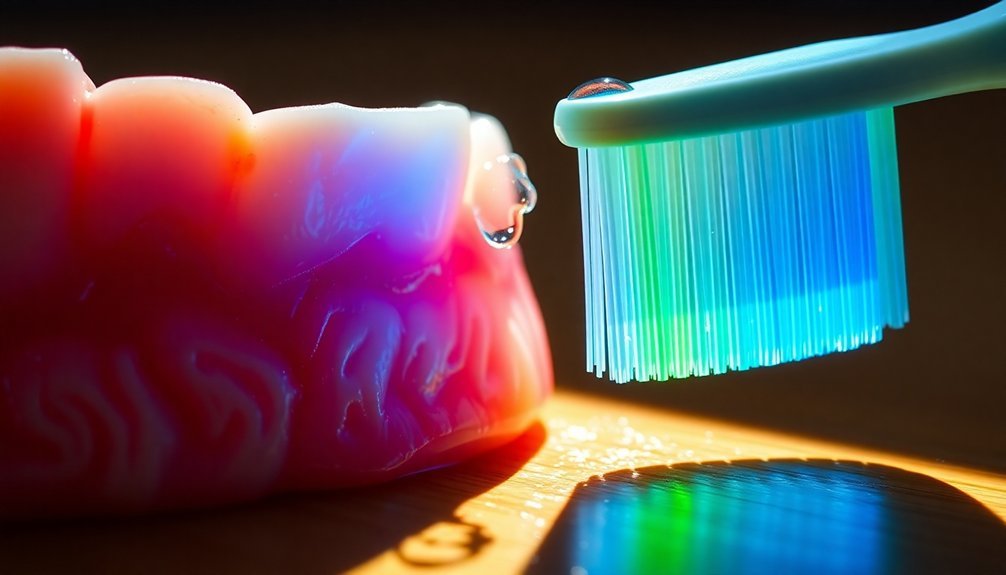



Leave a Reply